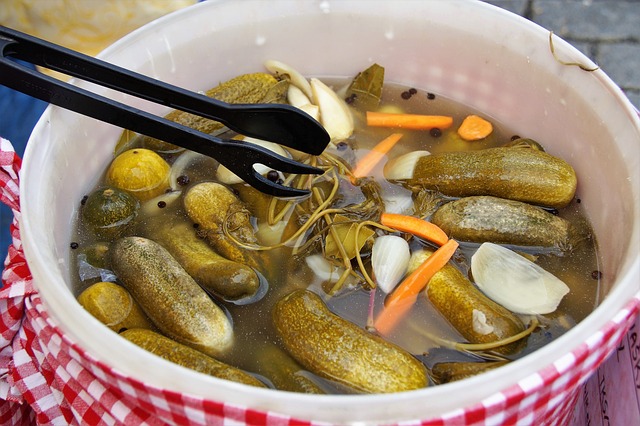Old-fashioned fermented pickles are a delicious and healthy way to preserve cucumbers. Unlike modern pickles that use vinegar, traditional fermented pickles rely on natural fermentation to develop their tangy flavor. This process not only enhances the taste but also promotes the growth of beneficial probiotics. Follow this step-by-step guide to create your own batch of old-fashioned fermented pickles.
Table of Contents
- Introduction to Fermented Pickles
- Equipment Needed
- Ingredients
- Step-by-Step Fermentation Process
- Preparing the Cucumbers
- Making the Brine
- Fermenting the Pickles
- Storing the Pickles
- Tips for Successful Fermentation
- Troubleshooting Common Issues
- Conclusion
1. Introduction to Fermented Pickles
Fermented pickles are made by immersing cucumbers in a brine solution and allowing them to ferment at room temperature. The fermentation process is driven by naturally occurring lactic acid bacteria, which convert sugars in the cucumbers into lactic acid. This not only preserves the cucumbers but also gives them their characteristic sour taste and crunchy texture.
2. Equipment Needed
To make old-fashioned fermented pickles, you will need the following equipment:
- Large Glass Jar or Crock: Use a non-reactive container for fermentation, such as a glass jar or ceramic crock.
- Plate or Fermentation Weight: To keep the cucumbers submerged in the brine.
- Clean Cloth or Lid: To cover the jar and allow gases to escape while keeping contaminants out.
- Tongs or Clean Hands: For handling the cucumbers.
3. Ingredients
The ingredients for fermented pickles are simple and straightforward:
- Fresh Cucumbers: Use small, firm cucumbers, preferably pickling varieties.
- Non-Iodized Salt: Use sea salt or kosher salt to create the brine.
- Water: Use filtered or distilled water to avoid chlorine and other additives.
- Spices and Herbs: Common additions include garlic, dill, mustard seeds, peppercorns, and bay leaves.
- Optional Additions: Grape leaves or horseradish leaves to keep the pickles crisp.
4. Step-by-Step Fermentation Process
Preparing the Cucumbers
- Select Fresh Cucumbers: Choose cucumbers that are firm and free from blemishes.
- Wash the Cucumbers: Rinse the cucumbers thoroughly under cold water to remove any dirt.
- Trim the Ends: Cut off the blossom end of each cucumber to prevent them from becoming soft during fermentation.
Making the Brine
- Dissolve Salt in Water: Mix 3 tablespoons of non-iodized salt per quart (4 cups) of water. Stir until the salt is completely dissolved.
- Add Spices and Herbs: Place garlic, dill, mustard seeds, peppercorns, and any other desired spices at the bottom of the jar.
Fermenting the Pickles
- Pack the Jar: Place the cucumbers vertically in the jar, packing them tightly but allowing enough space for the brine to circulate.
- Pour the Brine: Pour the saltwater brine over the cucumbers, ensuring they are fully submerged. Leave about 1 inch of headspace at the top of the jar.
- Weigh Down the Cucumbers: Use a plate, fermentation weight, or a clean rock to keep the cucumbers submerged under the brine.
- Cover the Jar: Cover the jar with a clean cloth or loose-fitting lid to allow gases to escape while keeping contaminants out.
- Ferment at Room Temperature: Place the jar in a cool, dark place at room temperature (65-75°F). Fermentation time can range from 3 days to 2 weeks, depending on the temperature and your taste preference.
Storing the Pickles
- Check the Pickles: Taste the pickles after 3-5 days. If they are not tangy enough, allow them to ferment longer.
- Store in the Refrigerator: Once the pickles reach the desired level of tanginess, transfer the jar to the refrigerator. The cool temperature will slow down the fermentation process and preserve the pickles.
5. Tips for Successful Fermentation
- Use Fresh Ingredients: Fresh cucumbers and herbs will result in the best-tasting pickles.
- Maintain Cleanliness: Ensure all equipment and hands are clean to prevent contamination.
- Monitor Temperature: Keep the fermenting pickles at a consistent temperature for optimal fermentation.
- Keep Cucumbers Submerged: Prevent mold and spoilage by keeping the cucumbers fully submerged in the brine.
6. Troubleshooting Common Issues
- Cloudy Brine: A cloudy brine is normal and usually indicates healthy fermentation.
- Mold: If mold appears on the surface, skim it off and ensure the cucumbers are fully submerged. If mold is extensive, discard the batch and start over.
- Soft Pickles: Adding grape leaves or horseradish leaves can help keep pickles crisp. Also, ensure the cucumbers are fresh and the blossom ends are trimmed.
7. Conclusion
Making old-fashioned fermented pickles is a simple and rewarding process that yields delicious, tangy, and probiotic-rich pickles. By following these steps and tips, you can create your own batch of homemade fermented pickles that will add a delightful crunch to your meals.

